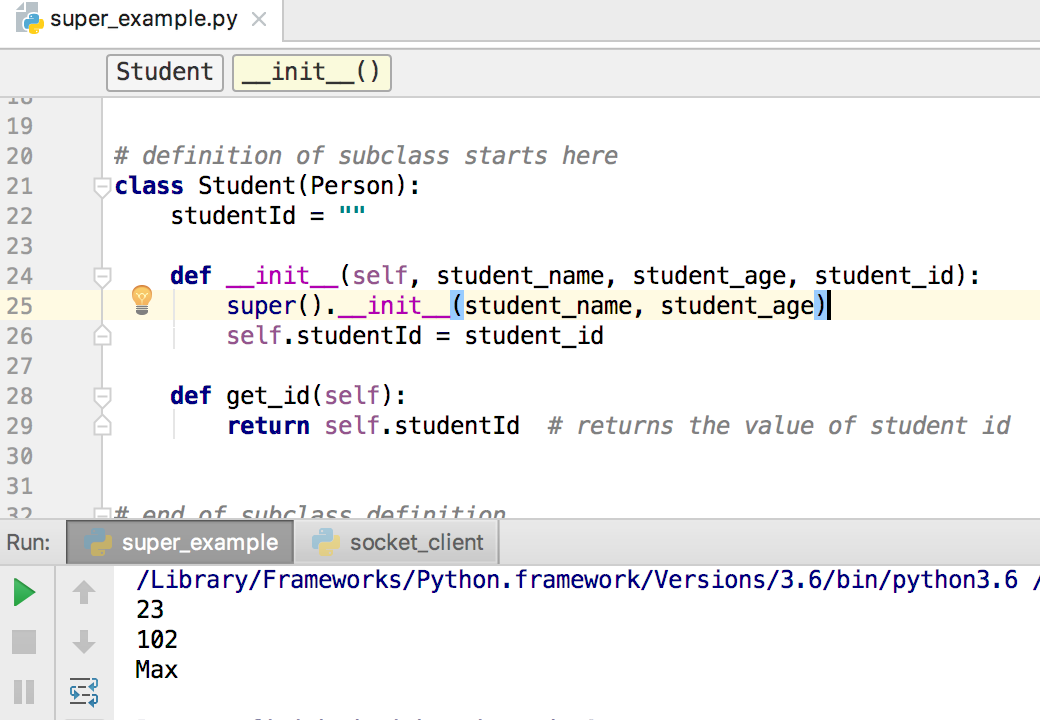Pythonのsuper()関数は、明示的に親クラスを参照することができます。これは、親クラスの関数を呼び出したい場合に便利です。
Pythonのsuper
Pythonのsuper()関数を理解するには、Pythonの継承について知っておく必要があります。Pythonの継承では、サブクラスがスーパークラスから継承されます。Pythonのsuper()関数を使うことで、スーパークラスを暗黙的に参照することができます。したがって、Pythonのsuperは私たちの作業をより簡単で快適にします。サブクラスからスーパークラスを参照する際に、スーパークラスの名前を明示的に書く必要はありません。以下のセクションでは、Pythonのsuper関数について説明します。
Pythonのsuper関数の例
まず、次のコードを見てみましょう。これは、Pythonの継承チュートリアルで使用したコードです。この例のコードでは、スーパークラスはPersonであり、サブクラスはStudentです。したがって、コードは以下のようになります。
class Person:
# 変数の初期化
name = ""
age = 0
# コンストラクタの定義
def __init__(self, person_name, person_age):
self.name = person_name
self.age = person_age
# クラスメソッドの定義
def show_name(self):
print(self.name)
def show_age(self):
print(self.age)
# サブクラスの定義がここから始まります
class Student(Person):
studentId = ""
def __init__(self, student_name, student_age, student_id):
Person.__init__(self, student_name, student_age)
self.studentId = student_id
def get_id(self):
return self.studentId # returns the value of student id
# サブクラスの定義の終わり
# スーパークラスのオブジェクトを作成
person1 = Person("Richard", 23)
# オブジェクトのメンバーメソッドを呼び出す
person1.show_age()
# サブクラスのオブジェクトを作成
student1 = Student("Max", 22, "102")
print(student1.get_id())
student1.show_name()
上記の例では、親クラスの関数を呼び出しています:
Person.__init__(self, student_name, student_age)
これを以下のようにPythonのsuper関数呼び出しで置き換えることができます。
super().__init__(student_name, student_age)
出力は、以下の画像に示すように、両方の場合で同じままです。
Python 3 super
上記の構文は、Python 3のsuper関数のものです。Python 2.xバージョンを使用している場合、やや異なりますので、以下の変更を行う必要があります。
class Person(object):
...
super(Student, self).__init__(student_name, student_age)
最初の変更は、Personの基本クラスとしてobjectを持つことです。Python 2.xバージョンでは、super関数を使用する必要があります。さもないと、次のエラーが発生します。
Traceback (most recent call last):
File "super_example.py", line 40, in <module>
student1 = Student("Max", 22, "102")
File "super_example.py", line 25, in __init__
super(Student, self).__init__(student_name, student_age)
TypeError: must be type, not classobj
super関数の構文自体の2番目の変更です。Python 3のsuper関数が使いやすく、構文も見やすいことがわかります。
Pythonのスーパー関数と多段階の継承
以前に述べたように、Pythonのsuper()関数はスーパークラスを暗黙的に参照できるようにします。ただし、多段階の継承の場合、どのクラスを参照するのでしょうか?実際、Pythonのsuper()は常に直接のスーパークラスを参照します。また、Pythonのsuper()関数は__init__()関数だけでなく、スーパークラスのすべての他の関数を呼び出すこともできます。次の例で確認しましょう。
class A:
def __init__(self):
print('Initializing: class A')
def sub_method(self, b):
print('Printing from class A:', b)
class B(A):
def __init__(self):
print('Initializing: class B')
super().__init__()
def sub_method(self, b):
print('Printing from class B:', b)
super().sub_method(b + 1)
class C(B):
def __init__(self):
print('Initializing: class C')
super().__init__()
def sub_method(self, b):
print('Printing from class C:', b)
super().sub_method(b + 1)
if __name__ == '__main__':
c = C()
c.sub_method(1)
上記のPython 3スーパーの多段階継承の例の出力を見てみましょう。
Initializing: class C
Initializing: class B
Initializing: class A
Printing from class C: 1
Printing from class B: 2
Printing from class A: 3
したがって、出力から明らかなように、クラスCの__init__()関数が最初に呼び出され、次にクラスB、最後にクラスAが呼び出されました。同様のことがsub_method()関数を呼び出すことで起こりました。
なぜPythonのsuper関数が必要なのか
もしJava言語の以前の経験があるなら、基本クラスもそこでsuperオブジェクトとして呼び出されることを知っているはずです。したがって、このコンセプトは実際にはコーダーにとって有用です。ただし、Pythonもプログラマーがスーパークラス名を使用してそれらを参照する機能を保持しています。そして、プログラムに多段階の継承が含まれている場合、このsuper()関数は役立ちます。これがPythonのsuper関数に関するすべてです。このトピックを理解していただけたと思います。疑問がある場合はコメントボックスをご利用ください。
完全なPythonスクリプトやその他のPythonの例は、当社のGitHubリポジトリからご覧いただけます。
参考文献:公式ドキュメント
Source:
https://www.digitalocean.com/community/tutorials/python-super













